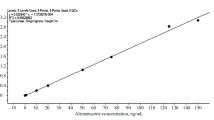Summary
In a single dose, randomized, cross-over study, with one week of wash-out period, the relative bioavailability of Dopegyt® tablets containing 250 mg alpha-methyldopa (AMD) and Presinol® film tablets with identical active ingredient content was examined in 24 healthy volunteers.
Since technologically two completely different preparations (a film-tablet and a non-film-tablet) having significantly different in vitro dissolution were to be compared, both preparations were compared to a third one, AMD solution (Dopegyt® solution) with 250 mg/50 ml concentration. Plasma concentrations of the drug were measured for 24 hours post-dose, applying HPLC with fluorometric detection. Pharmacokinetic parameters calculated from individual data (AUC0−∞, AUC0−t, Cmax, Cmax/AUC0−∞, tmax) were evaluated statistically. Wilcoxon’s nonparametric test and the four-way variance analysis could not detect any significant difference at the usual a=95% probability level in these pharmacokinetic parameters of the two tablet preparations. For AUC0−∞ at the 90% probability level, the confidence interval was 0.883–1.237 (with an estimated geometric mean of 1.045), for the test/reference ratio of Dopegyt® and Presinol® tablets, thus the two preparations proved to be bioequivalent. The relative bioavailability of Dopegyt® (test preparation) and Presinol® (reference preparation) calculated from the AUC0−∞ values was 116.7±56.7% that also confirmed bioequivalence. The results of all the applied statistical tests suggest that Dopegyt® and Presinol® can be considered as bioequivalent preparations.
Similar content being viewed by others
References
Oates, J.A., Gillespie, L., Udenfriend, S., Sjoerdsma, A. (1961): Decarboxylase inhibition and blood pressure reduction by alpha-methyl-3,4-dihydroxy-DL-phenylalanine. Science, 131. 1890–1894.
Au, W.Y.W., Dring, L.G., Grahame-Smith, I. Isaac, P. and Williams, R.T. (1972): The metabolism of 14C-labeled alpha-methyldopa in normal and hypertensive human subjects. Biochem. J. 129. 1–6.
Saavedra, J.A., Reid, J.L., Jordan, W., Rawlins, M.D., Dollery, C.T. (1975): Plasma concentration of alpha-methyldopa and methyldopa hydrochloride ethyl ester. Eur. J. Clin. Pharmacol, 8. 381–385
Skerjanec, A., Campbell, N.R.C., Robertson, S., Tam, Y.K. (1995): Pharmacokinetics and presystemic gut metabolism of methyldopa in healthy human subjects. Eur. J. Clin. Pharmacol, 35. 275–279.
Myhre, E. (1972): Plasma turnover of methyldopa in advanced renal failure. Acta Med. Scand. 191. 343–348.
Kim, B.K., Koda, R.T. (1977): Fluorometric determination of methyldopa in biological fluids. J. Pharm. Sci., 66. 1632–1637.
Róna, K., Gachályi, B., Vereczkey, L., Nádas, B., Káldor, A. (1987): Comparative bioavailability study of two preparations of alpha-methyldopa after single oral doses. Int. J. Clin. Pharm. Ther. and Tox. 25: 515–517.
Hoskins, J.A., Holliday, S.B. (1982): Determination of alpha-methyldopa and methyldopate in human breast milk and plasma by ion-exchange chromatography using electrochemical detection. J. Chromatogr. 230. 162–166.
Ong, H., Sved, S., Beaudoin, N. (1982): Assay and stability of alpha-methyldopa in man using high-performance liquid chromatography with electrochemical detection. J. Chromatogr. 229. 433–435.
Nelson, L.M., Carruthers, M. (1980): Semi-automated fluorometric method for the estimation of urinary catecholamines using high-performance liquid chromatography. J. Chromatogr. 183. 295–299.
Róna, K., Ary, K., Gachályi, B., Klebovich, I. (1996): Determination of alpha-methyldopa from human plasma by validated high-performance liquid chromatographic method with fluorescence detection. J. Chromatogr. A. 730. 125–131.
Campbell, N. R. C., Skerjanec, A., Tam, Y., Robertson, S., Burgess, E. (1995): Methyldopa kinetics before and after ingestion of methyldopa for eight weeks. Eur. J. Clin. Pharmacol. 48. 397–400.
Drugs Directorate Guidelines (1992): Conduct and analysis of bioavailability and bioequivalence studies. Health and Welfare Canada, Ottawa.
Guidance, statistical process for bioequivalence studies using a standard two-treatment cross-over design. Food and Drug Administration (FDA), Division of Bioequivalence, Office of Generic Drugs, Rockville, MD, USA (1992).
Blume, H. H., Sievert, M. (1987): Qualitatsbeurteilung von wirkstoffgleichen Fertigarzneimitteln (Generik). Schriftereiche der Bayerishen Landesapotheker-kammer, Heft 36, München.
Good Clinical Practice (1994), Guideline for essencial documents for the conduct of a clinical trial, Comission of the European Communities, II/5058/94, Brusseles.
The OECD principles off Good Laboratory Practice (1992) OCDE/GD (92) 32, OECD, Paris.
Good Laboratory Practice (1993) Marcel Dekker, Inc., New York.
Shah, V. P., Midha, K. K., Dighe, S., McGilvery, I. J., Skelly, J. P., Yacobi, A., Layloft, T., Viswanathan, C. T., Cook, C. E., McDowall, R. D., Pittman, K. A., Spector, S., (1992): Analytical method validation, bioavailability, bioequivalence and pharmacokinetic studies. J. Pharm. Sci., 81, 309–312.
Bressolle, F., Bromet-Petit, M., Audran, M. (1996): Validation of liquid chromatographic and gas chromatographic method. Applications to pharmaco-kinetic. J. Chromatogr. B. 686, 3–10.
Endrényi, L., Fritsch, S., Yan, W. (1991): Cmax/AUC is a clearer measure than Cmax for absorption rates in investigations of bioequivalence. Int. J. Clin. Pharmacol. Ther. Toxicol. 29. 394–399.
Sváb, J. (1979): Multivariate methods in biometry (in Hung.). Mezôgazdasa-gi Kiadó, Budapest
Blume, H. H, Midha, K.K. (1993): Report of consensus meeting, Bio-International ′92, Conference on bioavailability, bioequivalence and pharmacokinetic studies. Eur. J. Pharmaceut. Sci., 1. 165–171.
Blume, H. H., Midha, K. K. (1995): Bio-International 2. Bioavailability bioequivalence and pharmacokinetic studies Medipharm Scientific Publishers, Stuttgart.
Author information
Authors and Affiliations
Rights and permissions
About this article
Cite this article
Róna, K., Ary, K., Renczes, G. et al. Comparative bioavailability of alpha-methyldopa normal and film tablet formulations after single oral administration in healthy volunteers. Eur. J. Drug Metab. Pharmacokinet. 26, 25–30 (2001). https://doi.org/10.1007/BF03190372
Received:
Issue Date:
DOI: https://doi.org/10.1007/BF03190372




